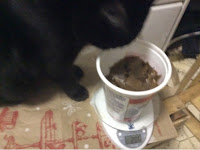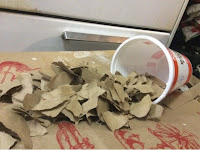Watch with glittering eyes the whole world around you, because the greatest secrets are always hidden in the most unlikely places. Those who dont believe in magic will never find it. -Roald Dahl


Hosted by PELUM KENYA, the conference center was beautiful, located on what felt like a mini farm with lush gardens, ponds and even hutches of rabbits. It was such a privilege to participate in conversation with this rich, knowledgeable and diverse group of people. Some of the organizations represented at the conference were PELUM, ILEIA, MESA, Muliru Farmers Group, African Biodiversity Network, South Indian Federation of Fishermen Society, Earth Net Foundation, Dhan Foundation India, WESA and South Alliance for Indigenous Resources.
?
As part of the conference we went on two field trips to local farming projects. The first was to the Thoma Wa Mukamba Community Cultural Learning Center. This group focuses on traditional seed saving specifically ten native food crops. They are reviving indigenous seeds and cultural foods made with these traditional crops.
?
The highlight was visiting H.I.M. Negus Shiriki Community, a Rastafarian community of artists and youth from Nairobi. This is hands down the most magical farm I have ever seen.
(click the link to learn more about this inspiring group and our visit)
These brothers and sisters are incredible artists who create mosaic murals and make clothing and sandals with an ancient style of Kemetic weaving. They are stewarding land in the Maragua district of Kenya. I have never seen a farm so amazing. The diversity of vegetation grown there for food and medicine is astounding as well as the abundance and health of the plants. I cant describe how much I felt at home there, I didnt want to leave!
We received a tour of the gardens from Brother herbalist and medicine man Ras Abasa and little four year old Sista Menen (who knows all the plants and can tell you their medicinal uses!) We also helped plant fruit trees.
We had the opportunity to see some of the craftsmanship handmade by Sista Njoki, beautiful sandals and many types of jewelry. We also got to meet her two month old twins sons, Jahwise and Jahsent.
The biggest blessing of the visit was the nourishing, homegrown ital meal and tea made
with lemongrass, ginger root and coconut milk. Heaven! A piece of my soul will forever reside with the Shiriki Community. Peace and Blessings be upon them and may their natural way of life be preserved!
After the conference we spent another week in Kenya and stayed with some MESA friends at the GBIAK farm. GBIAK stands for Grow Bio intensive Agriculture Kenya.
GBIAK is run by two incredible farmers who have a mission to teach bio intensive and sustainable agriculture to all those who come to learn. The first day we arrived they were holding a workshop for indigenous farmers from the northern region who had been using synthetic fertilizers and had depleted their soils.
Corn, sorghum, papaya, mangoes, jute, amaranth, sun hemp, nightshade, squash, okra, melons, greens, sweet potatoes, and bamboo are just a few of the crops grown here. GBIAK uses the farming methods of John Jeavons. They are a perfect model of bio intensive agriculture, a prolific amount of food grown on a few acres.
The most inspiring part of visiting GBIAK was their seed bank. I fell in love with this idea and immediately wanted to build one back home. Farmers come from all around to purchase organic seeds from this bank at one dollar per spoonful.
I bought many varieties I am excited to try; drought resistant corn, sun hemp, jute, moringa, black amaranth, and others. I managed to successfully smuggle them all home in my dirty pairs of socks!
During the rest of our trip we stayed in Nairobi and explored the city. Of course we had to spend a full day at the Masai market. So many amazing handmade goods and colors! It was a bit of an overwhelming experience until I learned I had to bargain!
More adventures included visits to the elephant orphanage, lots of babies ages ranging from a few months to three years old.
My friend got lots of muddy elephant love.
This is Ed who I met at the Giraffe sanctuary. He was surprisingly affectionate with his long neck hugs. Toward the end of our trip we went on safari and saw all the incredible animals living in the park. The day ended with a pride of seven lions about twenty yards from us. So majestic!
We ended up spending a day and a half in Ethiopia on our way home, also beautiful to tour Addis Ababa on foot. Traveling to Africa was an opportunity of a lifetime. There is so much more I could say about my adventures. I left out a lot of the magical experiences. The inspiration and expansion I experienced cannot be put into words. In a nutshell this trip was a healing gift...life changing. Thank you and gratitude to my supportive family and to PELUM Kenya for making it possible for me to have this experience! I am so grateful for the new friendships I have made and we are already implementing many of the ideas I learned about here on our farm. Give thanks for continuous growth and learning!AMANI NA UPENDOPeace and Love!
 components, a lot longer and more complicated sketch, and probably longer debugging time, when I upload the make the robot walk sketch and hit the run switch, Ill have the satisfaction of seeing the robot walk across the room! Or the Halloween decoration light up and emit scary sounds. Or the garden sensors check the soil moisture to let me know if the tomatoes need to be watered.
components, a lot longer and more complicated sketch, and probably longer debugging time, when I upload the make the robot walk sketch and hit the run switch, Ill have the satisfaction of seeing the robot walk across the room! Or the Halloween decoration light up and emit scary sounds. Or the garden sensors check the soil moisture to let me know if the tomatoes need to be watered. I had started on the #2 video about a week back, but last week needed to return the borrowed Arduino components to the friend from whom I had borrowed them. The official Arduino Starter Kit I had ordered from Amazon showed up on Thursday. So I now had the parts I needed to resume learning about the basics of microcontrollers.
I had started on the #2 video about a week back, but last week needed to return the borrowed Arduino components to the friend from whom I had borrowed them. The official Arduino Starter Kit I had ordered from Amazon showed up on Thursday. So I now had the parts I needed to resume learning about the basics of microcontrollers.









































